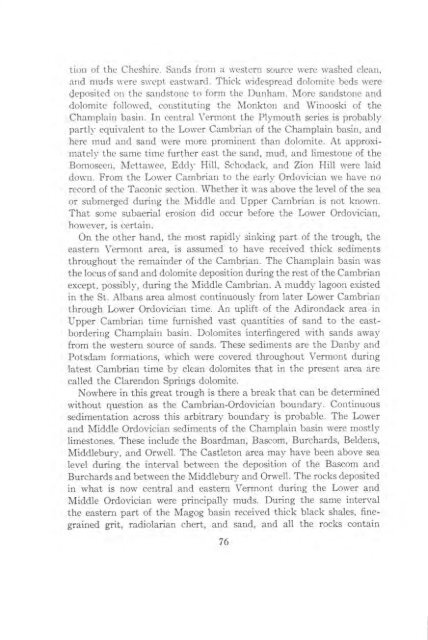STRATIGRAPHY AND STRUCTURE CASTLETON AREA VERMONT
STRATIGRAPHY AND STRUCTURE CASTLETON AREA VERMONT
STRATIGRAPHY AND STRUCTURE CASTLETON AREA VERMONT
Create successful ePaper yourself
Turn your PDF publications into a flip-book with our unique Google optimized e-Paper software.
tion of the Cheshire. Sands from a western source were washed clean,<br />
and muds were swept eastward. Thick widespread dolomite beds were<br />
deposited on the sandstone to form the Dunham. More sandstone and<br />
dolomite followed, constituting the Monkton and Winooski of the<br />
Champlain basin. In central Vermont the Plymouth series is probably<br />
partly equivalent to the Lower Cambrian of the Champlain basin, and<br />
here mud and sand were more prominent than dolomite. At approximatelv<br />
the same time further east the sand, mud, and limestone of the<br />
Bomoseen, Mettawee, Eddy Hill, Schodack, and Zion Hill were laid<br />
down. From the Lower Cambrian to the early Ordovician we have no<br />
record of the Taconic section. Whether it was above the level of the sea<br />
or submerged during the Middle and Upper Cambrian is not known.<br />
That some subaerial erosion did occur before the Lower Ordovician,<br />
however, is certain.<br />
On the other hand, the most rapidly sinking part of the trough, the<br />
eastern Vermont area, is assumed to have received thick sediments<br />
throughout the remainder of the Cambrian. The Champlain basin was<br />
the locus of sand and dolomite deposition during the rest of the Cambrian<br />
except, possibly, during the Middle Cambrian. A muddy lagoon existed<br />
in the St. Albans area almost continuously from later Lower Cambrian<br />
through Lower Ordovician time. An uplift of the Adirondack area in<br />
Upper Cambrian time furnished vast quantities of sand to the eastbordering<br />
Champlain basin. Dolomites interfingered with sands away<br />
from the western source of sands. These sediments are the Danby and<br />
Potsdam formations, which were covered throughout Vermont during<br />
latest Cambrian time by clean dolomites that in the present area are<br />
called the Clarendon Springs dolomite.<br />
Nowhere in this great trough is there a break that can be determined<br />
without question as the Cambrian-Ordovician boundary. Continuous<br />
sedimentation across this arbitrary boundary is probable. The Lower<br />
and Middle Ordovician sediments of the Champlain basin were mostly<br />
limestones. These include the Boardman, Bascom, Burchards, Beldens,<br />
Middlebury, and Orwell. The Castleton area may have been above sea<br />
level during the interval between the deposition of the Bascom and<br />
Burchards and between the Middlebury and Orwell. The rocks deposited<br />
in what is now central and eastern Vermont during the Lower and<br />
Middle Ordovician were principally muds. During the same interval<br />
the eastern part of the Magog basin received thick black shales, finegrained<br />
grit, radiolarian chert, and sand, and all the rocks contain<br />
76













